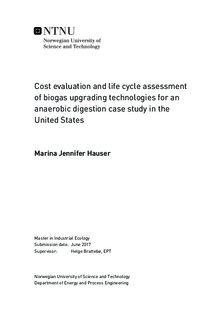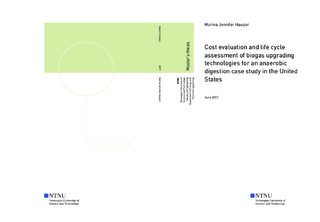| dc.description.abstract | Globally, around one third of the food produced is lost or wasted. Instead of landfilling or incinerating, organic municipal solid waste has increasingly been used in anaerobic digestion in order to produce biogas. The produced biogas contains around 60-70% methane, 30-40% carbon dioxide, and minor parts of impurities such as hydrogen sulfide, nitrogen, or water vapor. The biogas can be cleaned of impurities and upgraded by removing the carbon dioxide to substitute either natural gas in the national gas grid or liquid natural gas for vehicles. Different technologies exist for the removal of the carbon dioxide. The most widely used technologies are pressure swing adsorption, water scrubbing, amine scrubbing, membrane separation, and cryogenic separation. These five technologies were assessed in this study using literature data.
The first purpose of this study is to evaluate the environmental impact of the anaerobic digestion with following biogas upgrading in the geographical context of the United States. A life cycle assessment considering all the impacts from the anaerobic digestion to the substitution of natural gas including the biogas upgrading technology, gas compression and possible leakages along the way was performed using the EASETECH software. The normalized results show that the largest impacts occur in Freshwater Eutrophication and Global Warming. The largest savings are achieved in Freshwater Ecotoxicity, followed by Marine Ecotoxicity, fossil Depletion and Human Toxicity. Of the total 14 impact categories, cryogenic separation had the largest saving in eight impact categories and the largest impact in only one. However, including the sensitivity analysis, it was found that the uncertainty is so large that the error bars overlap for most impact categories and it is therefore most of the time not possible to show clearly which category is best or worst. Only for climate change, cryogenic separation clearly had the smallest impact, and for human toxicity and marine ecotoxicity, cryogenic separation clearly had the largest saving. It was also found that for the two impact categories with the largest environmental impact, the biogas production of the anaerobic digestion was the major contributing process for three of the scenarios. For the four impact categories with a negative impact, the substitution of natural gas was the major contributor.
This study also evaluates the costs and revenues associated with the anaerobic digestion and the following biogas upgrading. The calculations included investment cost, yearly costs, as well as income from tipping fees, the sale of biogas, and the sale of digestate. The net present value was calculated for plants with three raw biogas flow rates to compare the profitability of anaerobic digestion with following pressure swing adsorption, water scrubbing, and amine scrubbing. The analysis showed that water scrubbing and amine scrubbing had similar net present values, whereas the net present values for pressure swing adsorption was considerably lower. The sensitivity analysis showed that the factors with the largest sensitivity are the tipping fee and the biogas yield of the food waste which are both part of the anaerobic digestion. However, there is large uncertainty in the data used. Only one set of data was available from literature. Also, this data is from Europe and from 2008 adding additional uncertainty.
The conclusion was that depending on the goal of a project, such as low environmental impact, high energy efficiency, low methane slip, etc., a different technology may be preferred. Also, in order to get a complete picture, data from real plants need to be available. | |

